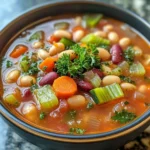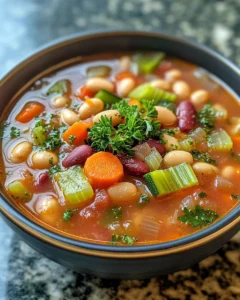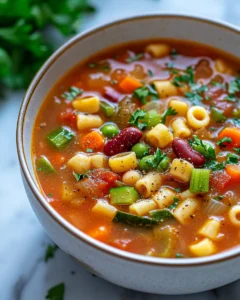There’s nothing quite like a steaming bowl of minestrone soup on a cool afternoon, its rich aroma filling the kitchen and warming the soul. This Minestrone Garden Fresh Soup is the ultimate comfort food, brimming with fresh vegetables, hearty beans, and tender pasta. Inspired by traditional Italian family recipes, this soup is a celebration of garden-fresh produce and simple, wholesome ingredients. Perfect for a cozy evening, a weeknight dinner, or even as a starter for a festive meal, it brings the flavors of Italy straight to your home. Whether you’re cooking for family or entertaining friends, this vibrant soup promises to be a crowd-pleaser, nourishing both body and spirit.
Ingredients
-
2 tablespoons olive oil
-
1 medium onion, diced
-
2 cloves garlic, minced
-
2 medium carrots, peeled and diced
-
2 celery stalks, diced
-
1 medium zucchini, diced
-
1 medium potato, peeled and diced
-
1 cup green beans, trimmed and cut into 1-inch pieces
-
1 cup cabbage, shredded
-
1 can (15 oz) diced tomatoes, with juices
-
6 cups vegetable broth
-
1 teaspoon dried oregano
-
1 teaspoon dried basil
-
½ teaspoon dried thyme
-
Salt and black pepper, to taste
-
1 can (15 oz) cannellini beans, drained and rinsed
-
½ cup small pasta (such as ditalini or elbow macaroni)
-
2 tablespoons chopped fresh parsley
-
Grated Parmesan cheese, for serving (optional)
Directions
Sauté the Aromatics
Begin by heating olive oil in a large, heavy-bottomed pot over medium heat. Once the oil is shimmering, add the diced onion and cook, stirring occasionally, until it becomes soft and translucent, about 5 minutes. The gentle sautéing of onions releases natural sugars that form the base of flavor for the soup. Next, add the minced garlic, stirring constantly for 1–2 minutes until the aroma becomes fragrant. Be careful not to burn the garlic, as it can turn bitter. This simple combination of onions and garlic creates a savory foundation, essential for a rich and satisfying minestrone.
Add Root Vegetables
Once the aromatics are softened, incorporate the diced carrots, celery, and potato into the pot. Stir thoroughly to ensure each vegetable is coated in the olive oil and mingled with the onion and garlic. Allow the vegetables to cook for 5–7 minutes, stirring occasionally. This step helps soften the vegetables slightly and begins to develop their natural sweetness, which will balance the acidity of the tomatoes added later. As the root vegetables cook, the kitchen fills with a comforting aroma that signals the start of a hearty, nourishing soup.
Incorporate the Tomatoes and Broth
Pour in the diced tomatoes with their juices and the vegetable broth, stirring well to combine. The tomatoes bring acidity and depth to the soup, complementing the earthy flavors of the root vegetables. Add dried oregano, basil, and thyme to introduce aromatic herbal notes that are classic to traditional minestrone. Season the mixture with a pinch of salt and black pepper, adjusting to taste. Turn the heat to medium-high and bring the soup to a gentle boil. This step ensures the flavors begin to meld, creating a cohesive, robust base for the rest of the soup ingredients.
Simmer the Soup
After reaching a gentle boil, reduce the heat to low and allow the soup to simmer uncovered for about 15 minutes. Simmering encourages the flavors of the vegetables, herbs, and tomatoes to fully integrate. During this time, the root vegetables continue to soften while retaining just enough bite to add texture to the final dish. Stir occasionally to prevent sticking, and adjust seasoning as needed. The slow simmering process is key to developing the depth of flavor that makes homemade minestrone so irresistible.
Add Remaining Vegetables
Once the root vegetables have softened, add the zucchini, green beans, and cabbage. These vegetables cook faster and retain vibrant color when added later, keeping the soup visually appealing and texturally satisfying. Allow the soup to simmer for an additional 10–12 minutes, or until all vegetables are tender but not mushy. The combination of root and green vegetables ensures a balanced mix of flavors, textures, and nutrients in every spoonful.
Cook the Pasta Separately
While the soup is simmering, prepare the pasta in a separate pot of boiling, salted water. Cook according to the package instructions until al dente, then drain and set aside. Cooking the pasta separately prevents it from absorbing too much of the soup liquid and becoming overly soft, which can compromise the final texture of your minestrone. This step also allows you to store leftovers more easily without the pasta becoming mushy.
Add Beans and Pasta
Once the pasta is ready, stir the cannellini beans into the soup first, followed by the cooked pasta. Beans add protein and a creamy texture, enhancing the heartiness of the dish. Let the soup cook for an additional 5 minutes, allowing the pasta and beans to absorb the flavors of the broth. This final simmer ensures a harmonious balance between all ingredients, making each spoonful flavorful and satisfying.
Finish with Fresh Herbs
Remove the pot from the heat and stir in freshly chopped parsley. The parsley brightens the soup and adds a refreshing herbal note that contrasts beautifully with the richness of the broth. Taste the soup carefully and adjust seasoning with additional salt and black pepper as needed. Fresh herbs added at the end of cooking retain their vibrant flavor, elevating the overall dish.
Serve and Garnish
Ladle the hot soup into individual bowls, ensuring an even distribution of vegetables, beans, and pasta. Optionally, sprinkle with grated Parmesan cheese for a touch of savory richness. Serve immediately with crusty bread or rolls to soak up the flavorful broth. The result is a comforting, colorful, and nourishing soup that embodies the essence of Italian garden-fresh cooking.
Prep Time, Cook Time, Total Time, Yield
-
Prep Time: 20 minutes
-
Cook Time: 45 minutes
-
Total Time: 1 hour 5 minutes
-
Yield: 6–8 servings
Notes
-
Vegetable Variations: Feel free to swap in seasonal vegetables like spinach, peas, or bell peppers depending on what’s fresh in your garden.
-
Make it Ahead: Minestrone soup tastes even better the next day as the flavors continue to develop. Store in an airtight container in the refrigerator for up to 3 days.
-
Freezing Tips: This soup freezes well without the pasta. Add freshly cooked pasta when reheating.
-
Protein Boost: For added protein, include cooked chickpeas or small pieces of grilled chicken if desired.
-
Serving Suggestions: Serve with garlic bread, a light salad, or a sprinkle of fresh herbs for a complete Italian-inspired meal.
Health Benefits of Minestrone Soup
Minestrone soup is a powerhouse of nutrition. Packed with fiber-rich vegetables and beans, it supports digestive health and provides essential vitamins and minerals. The variety of colors in this garden-fresh version ensures a range of antioxidants that help protect your body from free radicals. Using vegetable broth and minimal oil keeps it light yet filling, making it an excellent choice for anyone seeking a wholesome, low-calorie meal.
Tips for the Perfect Minestrone
-
Balance of Vegetables: Include a mix of root vegetables, green vegetables, and legumes to ensure a rich, layered flavor profile.
-
Cooking Pasta Separately: Cooking pasta separately prevents it from becoming overly soft and helps maintain the perfect texture in the soup.
-
Layered Seasoning: Season in stages—start with salt during sautéing and adjust at the end—to achieve a well-rounded taste.
-
Fresh Herbs: Adding parsley or basil at the end brightens the flavor and adds a fresh note to the soup.
-
Consistency: If you prefer a thicker soup, slightly mash some of the beans or vegetables before serving.
Why This Minestrone Soup Stands Out
Unlike generic canned soups, this Minestrone Garden Fresh Soup is made with love and fresh ingredients. The medley of vegetables, perfectly cooked pasta, and aromatic herbs create a symphony of flavors in every spoonful. It’s versatile enough for weeknight dinners yet elegant enough for dinner parties. Each bowl is a celebration of natural ingredients, offering comfort, nutrition, and the taste of homemade Italian cuisine.
Serving Suggestions and Pairings
-
Pair with crusty Italian bread or garlic breadsticks for dipping.
-
A simple green salad with balsamic vinaigrette complements the hearty flavors of the soup.
-
Add a sprinkle of Parmesan or Pecorino Romano cheese for an indulgent touch.
-
Garnish with fresh basil leaves or a drizzle of extra virgin olive oil for added richness.
Frequently Asked Questions
1. Can I use frozen vegetables for minestrone soup?
Absolutely! Frozen vegetables are a convenient and nutritious option, especially when fresh produce is out of season. They are typically harvested and frozen at peak ripeness, which helps retain their flavor and nutrients. When using frozen vegetables in minestrone, it’s best to add them toward the end of the cooking process. This helps preserve their texture and color, preventing them from becoming mushy. For example, frozen peas, green beans, or corn can be stirred in during the final 5–10 minutes of simmering. Using frozen vegetables can also reduce prep time since they are often pre-cut and ready to go.
2. How do I make this soup vegan?
This Minestrone Garden Fresh Soup is naturally vegan. The base of the soup—vegetables, beans, pasta, and herbs—contains no animal products. The only ingredient that might not be vegan is the optional Parmesan cheese used for garnish. To keep the soup fully vegan, simply omit the cheese or substitute it with a plant-based alternative such as nutritional yeast or vegan Parmesan. This substitution still provides a subtle, savory flavor that complements the soup beautifully. Vegan minestrone is just as rich and satisfying as the traditional version, making it an excellent choice for plant-based diets or anyone looking to enjoy a lighter, wholesome meal.
3. Can I prepare this soup in advance?
Yes! Minestrone soup is an ideal make-ahead meal. In fact, letting the soup sit in the refrigerator for a few hours or overnight allows the flavors to develop and deepen, creating a more robust taste. Store the soup in an airtight container in the fridge for up to 3 days. When reheating, do so gently on the stove over low to medium heat, stirring occasionally to ensure even warming. If you added pasta to the soup initially, it may absorb some of the broth and become soft. To avoid this, store the pasta separately and add it just before serving. Preparing this soup in advance is perfect for busy weeknights or meal prep, offering convenience without compromising on flavor.
4. What type of beans works best?
Traditionally, cannellini beans are used in minestrone for their creamy texture and mild flavor, which pairs beautifully with vegetables and pasta. However, you can easily experiment with other types of beans depending on your preference or pantry availability. Kidney beans add a slightly firmer texture and deeper color, while chickpeas offer a nutty flavor and extra protein. Navy beans are also a great option for a smooth, soft texture. Using a combination of beans is another option that adds variety and additional nutrients to the soup. The key is to rinse canned beans thoroughly to remove excess sodium and ensure a clean flavor.
Print
Minestrone Garden Fresh Soup Recipe
- Total Time: 1 hour 5 minutes
- Yield: 6–8 servings 1x
Description
A hearty and nourishing soup packed with fresh vegetables, beans, and pasta. Perfect for cozy evenings or a comforting lunch, this minestrone soup brings the flavors of an Italian garden straight to your kitchen.
Ingredients
-
2 tablespoons olive oil
-
1 medium onion, diced
-
2 cloves garlic, minced
-
2 medium carrots, peeled and diced
-
2 celery stalks, diced
-
1 medium zucchini, diced
-
1 medium potato, peeled and diced
-
1 cup green beans, trimmed and cut into 1-inch pieces
-
1 cup cabbage, shredded
-
1 can (15 oz) diced tomatoes, with juices
-
6 cups vegetable broth
-
1 teaspoon dried oregano
-
1 teaspoon dried basil
-
½ teaspoon dried thyme
-
Salt and black pepper, to taste
-
1 can (15 oz) cannellini beans, drained and rinsed
-
½ cup small pasta (such as ditalini or elbow macaroni)
-
2 tablespoons chopped fresh parsley
-
Grated Parmesan cheese, for serving (optional)
Instructions
-
Heat olive oil in a large pot over medium heat. Add diced onion and cook until softened, about 5 minutes. Stir in minced garlic and sauté 1–2 minutes until fragrant.
-
Add diced carrots, celery, and potato. Stir to combine with aromatics and cook 5–7 minutes until slightly softened.
-
Pour in diced tomatoes with juices and vegetable broth. Stir in oregano, basil, and thyme. Season with salt and pepper. Bring to a gentle boil.
-
Reduce heat to low and simmer uncovered for 15 minutes, allowing flavors to meld.
-
Add zucchini, green beans, and cabbage. Simmer 10–12 minutes until vegetables are tender but still vibrant.
-
While soup simmers, cook pasta in a separate pot according to package instructions until al dente. Drain and set aside.
-
Stir cannellini beans into the soup, followed by cooked pasta. Cook an additional 5 minutes so flavors combine.
-
Remove from heat and stir in chopped parsley. Adjust seasoning with salt and pepper.
-
Ladle soup into bowls and sprinkle with Parmesan if desired. Serve hot with crusty bread.
Notes
-
Use seasonal vegetables or frozen vegetables as needed.
-
Soup tastes better the next day as flavors develop.
-
Freeze without pasta for up to 3 months; add freshly cooked pasta when reheating.
-
Optional protein additions: chickpeas, lentils, or small diced chicken.
-
Serve with garlic bread or a fresh salad for a complete meal.
- Prep Time: 20 minutes
- Cook Time: 45 minutes








